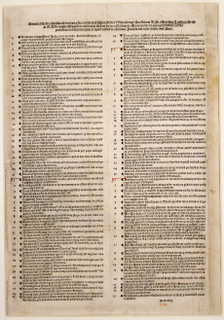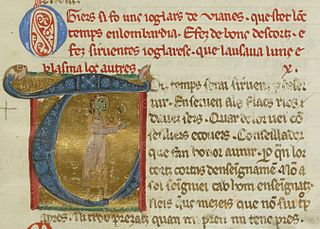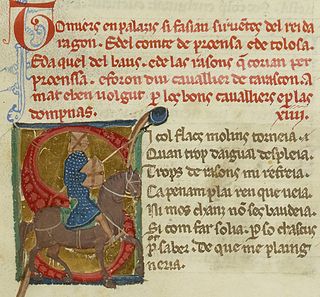Pope Urban II, otherwise known as Odo of Châtillon or Otho de Lagery, was the head of the Catholic Church and ruler of the Papal States from 12 March 1088 to his death. He is best known for initiating the Crusades.

The First Crusade (1096–1099) was the first of a series of religious wars, or Crusades, initiated, supported and at times directed by the Latin Church in the medieval period. The objective was the recovery of the Holy Land from Islamic rule. While Jerusalem had been under Muslim rule for hundreds of years, by the 11th century the Seljuk takeover of the region threatened local Christian populations, pilgrimages from the West, and the Byzantine Empire itself. The earliest initiative for the First Crusade began in 1095 when Byzantine emperor Alexios I Komnenos requested military support from the Council of Piacenza in the empire's conflict with the Seljuk-led Turks. This was followed later in the year by the Council of Clermont, during which Pope Urban II supported the Byzantine request for military assistance and also urged faithful Christians to undertake an armed pilgrimage to Jerusalem.

The Eighth Crusade was a crusade launched by Louis IX of France against the Hafsid dynasty in 1270. The Eighth Crusade is sometimes counted as the Seventh, if the Fifth and Sixth Crusades of Frederick II are counted as a single crusade. The Ninth Crusade is sometimes also counted as part of the Eighth. The crusade is considered a failure as Louis died shortly after arriving on the shores of Tunisia, with his disease-ridden army dispersing back to Europe soon afterwards.

The Ninety-five Theses or Disputation on the Power and Efficacy of Indulgences is a list of propositions for an academic disputation written in 1517 by Martin Luther, professor of moral theology at the University of Wittenberg, Germany, at the time controlled by the Electorate of Saxony. Retrospectively considered to signal the birth of Protestantism, this document advances Luther's positions against what he saw as the abuse of the practice of clergy selling plenary indulgences, which were certificates believed to reduce the temporal punishment in purgatory for sins committed by the purchasers or their loved ones. In the Theses, Luther claimed that the repentance required by Christ in order for sins to be forgiven involves inner spiritual repentance rather than merely external sacramental confession. He argued that indulgences led Christians to avoid true repentance and sorrow for sin, believing that they could forgo it by obtaining an indulgence. These indulgences, according to Luther, discouraged Christians from giving to the poor and performing other acts of mercy, which he attributed to a belief that indulgence certificates were more spiritually valuable. Though Luther claimed that his positions on indulgences accorded with those of the Pope, the Theses challenge a 14th-century papal bull stating that the pope could use the treasury of merit and the good deeds of past saints to forgive temporal punishment for sins. The Theses are framed as propositions to be argued in debate rather than necessarily representing Luther's opinions, but Luther later clarified his views in the Explanations of the Disputation Concerning the Value of Indulgences.

In the teaching of the Catholic Church, an indulgence is "a way to reduce the amount of punishment one has to undergo for sins". The Catechism of the Catholic Church describes an indulgence as "a remission before God of the temporal punishment due to sins whose guilt has already been forgiven, which the faithful Christian who is duly disposed gains under certain prescribed conditions through the action of the Church which, as the minister of redemption, dispenses and applies with authority the treasury of the satisfactions of Christ and all of the saints".

The Seventh Crusade (1248–1254) was the first of the two Crusades led by Louis IX of France. Also known as the Crusade of Louis IX to the Holy Land, it aimed to reclaim the Holy Land by attacking Egypt, the main seat of Muslim power in the Near East. The Crusade initially met with success but ended in defeat, with most of the army – including the king – captured by the Muslims.

The First Crusade inspired the Crusading movement which became one of the most significant attributes of late medieval western culture. The movement touched on every area of life, every European country, and the history of the western Islamic world. This influence is evident in the Church, religious thought, politics, the economy, and society. A distinct ideology is evident in the texts that described, regulated, and promoted crusading. The movement defined legal and theological terms based on the theory of Holy War and the concept of pilgrimage. Theologically this merged ideas from Old Testament parallels and Jewish wars that God instigated and assisted, with New Testament Christocentric viewpoints around forming personal relationships with Christ. Crusading as Holy war was based on the ancient idea of just war. The criteria were that a legitimate authority must initiate holy war, that there was just cause and waged with pure intentions. Crusades were special pilgrimages, a physical and spiritual journey under ecclesiastical authority and the protection of the church. Pilgrimage and crusade were penitential acts; popes considered crusaders earned a plenary indulgence giving remission of all God-imposed temporal penalties.

The Rhineland massacres, also known as the German Crusade of 1096 or Gzerot Tatnó, were a series of mass murders of Jews perpetrated by mobs of German Christians of the People's Crusade in the year 1096, or 4856 according to the Hebrew calendar. These massacres are often seen as the first in a sequence of antisemitic events in Europe which culminated in the Holocaust.

Frisian participation in the Crusades is attested from the very beginning of the First Crusade, but their presence is only felt substantially during the Fifth Crusade. They participated in almost all the major Crusades and the Reconquista. The Frisians are almost always referred to collectively by contemporary chroniclers of the Crusades and few names of individual Frisian crusaders have come down to us. They generally composed a naval force in conjunction with other larger bodies of crusaders.

Guillem AugierNovella was a troubadour from Vienne in the Dauphinois who lived most of his adulthood in Lombardy and was active as a minstrel in the early or mid thirteenth century. According to his late thirteenth-century vida, "he composed good descartz and sirventes in the manner of jongleurs, in which he praised some and blamed others."

Guillem or Guilhem Figueira or Figera was a Languedocian jongleur and troubadour from Toulouse active at the court of the Emperor Frederick II in the 1230s. He was a close associate of both Aimery de Pégulhan and Guillem Augier Novella.

Tomier and Palaizi were two knights and troubadours from Tarascon, possibly brothers, and frequent comrades and co-composers.

Peirol or Peiròl was an Auvergnat troubadour who wrote mostly cansos of courtly love in the late twelfth and early thirteenth centuries. Thirty-four surviving poems written in Occitan have been attributed to him; of these, seventeen have surviving melodies. He is sometimes called Peirol d'Auvergne or Peiròl d'Auvèrnha, and erroneously Pierol.
Ricaut Bonomel was a Knight Templar and troubadour in the Holy Land around the time of the Eighth Crusade. He was an outspoken critic of Charles I of Naples and his attempts to secure a throne in Italy, and of the Papal policy which diverted funds intended for the Holy Land to other purposes. He was also a vocal critic of the European clergy who did not preach crusading.
Guilhem or Guillem Fabre was a troubadour and burgher from Narbonne. He may be the same person as the dedicatee of En Guillems Fabres, sap fargar, a eulogistic poem by Bernart d'Auriac. He was one of several mid- to late-thirteenth-century troubadours from Narbonne, with Bernart Alanhan and Miquel de Castillon.

The historiography of the Crusades is the study of history-writing and the written history, especially as an academic discipline, regarding the military expeditions initially undertaken by European Christians in the 11th, 12th, or 13th centuries to the Holy Land. This scope was later this extended to include other campaigns initiated, supported, and sometimes directed by the Roman Catholic Church. The subject has involved competing and evolving interpretations since the capture of Jerusalem in 1099 until the present day. The religious idealism, use of martial force and pragmatic compromises made by those involved in crusading were controversial, both at the time and subsequently. Crusading was integral to Western European culture, with the ideas that shaped behaviour in the Late Middle Ages retaining currency beyond the 15th century in attitude rather than action.

The Barons' Crusade (1239–1241), also called the Crusade of 1239, was a crusade to the Holy Land that, in territorial terms, was the most successful crusade since the First Crusade. Called by pope Gregory IX, the Barons' Crusade broadly embodied the highest point of papal endeavor "to make crusading a universal Christian undertaking." Gregory IX called for a crusade in France, England, and Hungary with different degrees of success. Although the crusaders did not achieve any glorious military victories, they used diplomacy to successfully play the two warring factions of the Ayyubid dynasty against one another for even more concessions than Frederick II had gained during the more well-known Sixth Crusade. For a few years, the Barons' Crusade returned the Kingdom of Jerusalem to its largest size since 1187.
The Historia de via Hierosolymitana is a Latin epic verse history of the First Crusade. Originally composed before 1120 as a work in five books by Gilo of Toucy, it was expanded by the addition of four more by an anonymous poet known as "Fulco" or simply the "Charleville Poet". Although neither poet was an eyewitness, there are unique details in Gilo's work that suggest he had access to eyewitnesses.
The Crusade of 1129 or the Damascus Crusade was a military campaign of the Kingdom of Jerusalem with forces from the other crusader states and from western Europe against the Emirate of Damascus. The brainchild of King Baldwin II of Jerusalem, the crusade failed to meet its military objectives. Its diplomatic preliminaries, however, secured the succession to the throne of Jerusalem and papal backing for the Knights Templar.
The War of the Keys (1228–1230) was the first military conflict between Frederick II, Holy Roman Emperor, and the Papacy. Fighting took place in central and southern Italy. The Papacy made strong gains at first, securing the Papal States and invading the Kingdom of Sicily, while Frederick was away on the Sixth Crusade. Upon his return, he defeated the papal forces, forcing Pope Gregory IX to begin peace talks. After drawn-out negotiations, the treaty of San Germano terminated the conflict with no territorial changes.